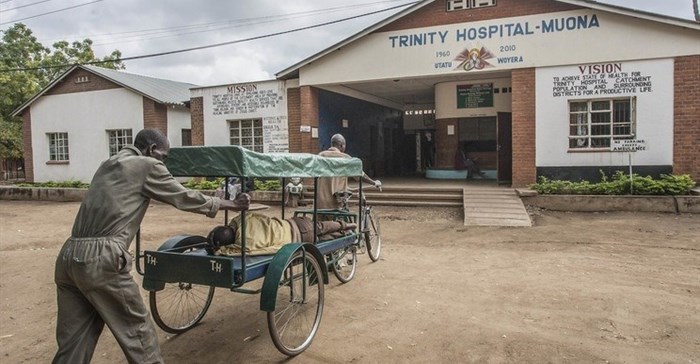
Top stories


EducationFrom adversity to opportunity: African education’s revival strategies
Sanjeev Mansotra 1 day



Marketing & MediaThe Odd Number named Financial Mail AdFocus Mid-Sized Agency of the Year
The Odd Number 1 day

More news











The women’s father, Stephan Nkhono, watches them from the doorway. “I didn’t think I would be here today,” he says.
Last year Nkhono fell ill. He had diarrhoea, a high temperature and was vomiting. He had malaria, which is endemic in the area. Although Trinity hospital is less than 2km from his home, Nkhono was too weak to walk.
“My relatives came here but there was no motor vehicle to take me to the hospital,” Nkhono recalls.

Even if the family had access to a car, they would have struggled to get him to the hospital. Nsanje is one of the districts hardest hit by the floods of 2015 and the infrastructural damage is yet to be repaired: the road leading to the Nkhono’s home is narrow, steep and bumpy.
“My family had to run to the hospital to collect the bicycle ambulance and used it to transport me to the hospital. That way they didn’t have to carry me and I was able to get help before it was too late,” he says.
The bicycles are especially designed to pull a stretcher or a similar structure, turning them into ambulances for use in rural areas where people struggle to get to clinics or hospitals because the facilities are too far away and the patient is too weak to walk.
“Normally, when we talk of ambulances, we always think of motor vehicles. But here in the rural areas, our village is difficult to access because our roads are very bad. It’s not everywhere where you can have motor vehicles,” says William Allan, the chief administrator at Trinity Hospital.
He removes his spectacles and wipes the sweat off his face and neck with a washcloth. In long, quick strides he walks down the crowded corridors of the hospital towards his office.
“A lot of people were dying, obviously, because they couldn’t reach the hospital. Many pregnant women would not make it to hospital in time and delivered their babies on their way here. As a result, many babies died, and so did some of their mothers.”
Transport is critical in healthcare access, according to a 2015 article in the journal, BMC Health Services Research.
Allan says many women in his village turned to traditional birth attendants when they could not get to the hospital, which often results in babies and mothers dying. Trinity Hospital has a catchment population of about 150,000 people.
“This hospital is strategically situated because the other hospitals are far. The nearest hospital is in Thyolo, which is 70km from here. Nsanje District Hospital is 80km to the south, but you cannot drive directly from here. Because the bridge we had was washed away by the floods, you have to travel 200km just to get to the other hospital,” says Allan.
A 2014 Pan African Medical Journal study in Kenya found that pregnant women whose medical care was delayed because of the long distance between their homes and the nearest health facility resulted in “some women arriving at the hospital too late to save the life of the unborn baby”.
Failure to access healthcare is also a key contributor to child mortality. A 2014 survey published in the Journal of Health, Population and Nutrition showed that children from poor households were less likely to be seen by a doctor when they are ill than their wealthier counterparts. Conducted in Malawi, the survey found that “families from rural households spent more time travelling compared to urban households. In addition, visiting a trained healthcare provider was associated with longer travel time and higher direct costs compared to visiting an untrained provider.”
Bicycle or bush ambulances were introduced at Trinity Hospital in 2002 when businessmen from Blantyre, Malawi’s commercial capital, donated the bicycles.
“Every group village headman was allowed to keep a bicycle ambulance so that if anybody in the village fell ill they could use the bush ambulance to take the patient to the hospital and then bring the bicycle back,” explains Allan.
“It was important to keep them in a central place so that anybody who can ride a bicycle can use the bush ambulance. Those who cannot ride a bicycle can just push it.”
Bicycle ambulances, which are provided mostly by charity organisations, are common in Malawian villages. They are also used in rural areas in Nepal, Uganda and Namibia.
But most of Trinity Hospital’s 12 bicycle ambulances are gone — there are only three left and they are badly damaged. “Unfortunately, we cannot trace where they are. If we had a GPS we could easily track down where they go.”
Some patients use spare parts from their own bicycles to fix bush ambulances but when they are done with an ambulance they take their spare parts back.
“One of the three bush ambulances we have left is new; we recently received it from Gift of the Givers,” says Allan. The international aid organisation works with rural communities and health officials around the country to “create committees to run the bicycle ambulance project at community level”. These committees raise funds each month to carry out any repairs needed on the bicycle ambulances. Gift of the Givers is hoping to establish similar groups in Nsanje.
But Allan says getting to the hospital is only one problem that rural communities face in getting medical care — the hospital is also severely understaffed.
Allan hopes to raise the funds for more bicycles. To prevent loss of the three remaining bicycle ambulances, he has enlisted the help of the village chiefs.
“We have talked to the traditional leadership to tell their people that the bicycle ambulances must remain at the hospital all the time when not in use. Whoever is found to have a bicycle ambulance at his home will be punished.”

This article was originally published by Bhekisisa, the Mail & Guardian’s Centre for Health Journalism. To read more
health stories from across Africa, go to bhekisisa.org